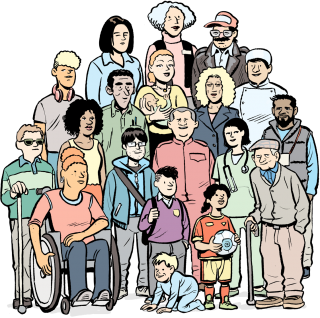World Happiness Report 2023

According to the World Happiness Report, published on the 21st March 2023, Ireland is the 14th happiest country in the world. Finland, for the sixth consecutive year, ranks first, followed by Denmark, Iceland, Israel, and the Netherlands. Sweden, Norway, Switzerland, Luxembourg and New Zealand make up the remainder of the top ten. Ireland ranks just behind Canada, and just ahead of the United States, Germany and Belgium.
What makes a 'happy' country?
Country rankings in the World Happiness Report 2023 (WHR) are based on subjective measures of wellbeing in 2020, 2021, and 2022. These measures include "life evaluations", that is a set of indicators such as income, health, having someone to count on, having a sense of freedom to make key life decisions, generosity, and the absence of corruption. The authors of the WHR also consider the role played by positive and negative emotions and the effects of well-being. There are also objectively measurable factors such as GDP, income, and life expectancy at birth.
As we saw in our Sustainable Progress Index, published in February this year, happiness or human flourishing requires many factors, most of which relate to social participation. In the 20th century many countries have achieved levels of per capita output which provide the material sufficiency needed for a decent standard of living. These countries have a higher level of happiness than those countries where material hardship is the norm. Yet there is a good deal of overlap in the happiness scores (using the WHR) between countries classified as High, Middle and Low Income by the World Bank.
There is a growing recognition that public policy needs to go beyond promoting GDP growth and target policies that will directly promote well-being. An early example of this message was John Kenneth Galbraith’s bestselling book The Affluent Society, published in 1958. Galbraith argues that more private production is not addressing the problems faced by an “affluent society,” that a better balance between public and private production is needed. Private solutions require profitability, so that the only problems that get addressed are those which enrich large corporations. Public spending on education and healthcare has a profound impact on well-being, even though it is often promoted because they are also major contributors to economic growth.
By the late 1990s there were increasing challenges to GDP as the primary metric for measuring economic and social progress. These challenges were on two broad fronts: environmental and social.[i] The environmental challenge noted that GDP did not adequately measure the costs and benefits of natural resources and ecological systems. Thus, environmentally damaging activities like burning coal are counted only as a plus to the national income accounts, with no adjustment for the negative effects. In fact, many of the negative effects (like spending on increased diseases caused by burning coal) are also counted as additions to GDP. The promotion of economic growth for the sake of economic growth is the main driver of the waste and pollution that is at the core of our current environmental crises.
The social challenge to GDP is based on the decoupling of well-being with GDP. After a certain level of GDP per capita is achieved, the link between higher levels of GDP and well-being and happiness becomes weaker and is often very small (and in some cases becomes negative). We see this in the relationship between GDP per capita and the Social Progress Index (one of the leading measures of well-being). We have produced versions of this relationship in previous reports.[ii] In these past reports we divided all countries based on GDP per capita above or below $30,000 to highlight the fall in the correlation coefficient between GDP per capita and the SPI. In this year’s report we have divided countries into three groups following the World Bank income group classification (which we mentioned above).[iii]
[i] See Scott, Nolan and Fahey, 1996, chapter 5 for an early review of these developments.
[ii] We have used the World Happiness Index instead of SPI and achieved the same results (Clark and Kavanagh, 2019, p. 19).
[iii] We have combined the Low and Lower Middle Countries into one group because there are so few countries in the Low Income group.